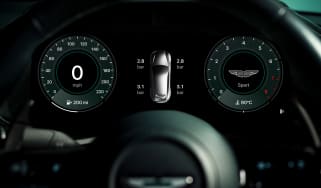Aston Martin One-77
Exclusive report on the most extreme Aston ever, the £1.2m, 730bhp, 200mph-plus ‘One-77’
It’s an unassuming industrial unit – the parts warehouse, in fact – but at the far end, through a door marked ‘strictly no cameras allowed’, is a walled-off area. This is where Aston Martin builds its prototypes, and today they’re making an exception to the no-cameras rule.
There’s a black V8 Vantage Roadster up on jacks and one or two others, but to be honest I’m not paying much attention as we’re led down a narrow corridor, past a couple of neat offices and through yet another security door (there’s a lot of those at Gaydon).
And we’re there, in Aston’s inner sanctum, an area even the staff are only allowed into on a ‘need to know’ basis. It’s like gaining entry to a safety deposit box in a vault buried in the bowels of the Bank of England.
The occupant of this secret chamber – and the focus of everyone’s attention – is levitating three feet in the air, supported on a hydraulic lift. It’s a One-77. Or so I assume – it’s a bit hard to tell at the moment since most of it is laid out on workbenches and shelving racks.
It’s definitely Aston-shaped though, given definition by the front and rear wings – the only outer surfaces attached to this, the second chassis to be built. The first was on display at the Geneva motor show last month, real proof that the One-77 was more than a figment of Aston boss Dr Ulrich Bez’s imagination. It was a naked rolling chassis and it looked amazing, more engineering sculpture than car. In fact one customer has demanded the right to buy two – a proper car to drive and an unskinned version to park in his living room. Aston is currently evaluating his request (‘two for £2million’ was a quote I heard backstage…).
So what is the One-77? Vanity project? Aston cashing in on the Veyron phenomenon? Or a genuine attempt to build a world-beating supercar? Probably a bit of all three, but certainly one of the most beautifully detailed and constructed cars ever to see the light of day.
Chris Porritt, chief programme manager for the car and our guide for the next few hours, is the man currently living and breathing – and breathing life into – this project. ‘The sort of inspiration we were looking at when we were doing the packaging was the DTM car,’ says Chris. ‘It fits what we were looking at with the carbonfibre monocoque and positioning the whole engine behind the front axle centre line, so it’s really far back and really low down.’
Hands up those who think drawing parallels between the German Touring Car Series and a classic British sports-car manufacturer sounds rather tenuous? Me too. But here’s the thing with the One-77: it takes current, familiar Aston technology – big V12, six-speed automated-manual transmission, hand-beaten body panels – and gives it the microscopic attention to detail that defines high-end motorsport applications.
Take the engine for instance. It starts out as the 5.9-litre V12 from the DB9, but the only common part is the timing chain, and by removing the iron cylinder liners and boring it out a fraction further it’s now a 7.3. Iron particles are then plasma-welded to the aluminium bores to a depth of six microns. ‘That alone saved us more than half the 60kg weight saving,’ reveals Porritt. Most of the rest came from dry-sumping the engine, although there are also small slots machined into the bottom of the block, simply to save a little more weight. The Cosworth-developed, 260kg V12 should develop around 730bhp.
The engine isn’t currently in the car, but is sitting alongside. Chris points out the billet machined front cover, the smaller flywheel to aid rev characteristics, the carbon cam covers and the intake variable valve timing. ‘It’s the first time we’ve done that on a V12,’ says Chris, adding, ‘Anything we’re doing here for efficiency or mass saving or cleaner operation could be used on future engines.’
What was most noticeable from the Geneva car (which will be the official customer demo car), was just how ground-hugging the One-77 is. The move to a dry sump means the V12 is mounted 100mm lower in the chassis, dropping the centre of gravity massively and allowing the driver to sit that much lower too.
There’s a delectable selection of magnificently detailed parts on the table alongside the car: an exotically twisted exhaust manifold, dampers, polished suspension mounts, the oil tank. It’s lovely to be able to pick bits up, turn them over, get a real idea of how they fit together. My personal favourite is the carbonfibre inner wing. Not only does the laughably light component perform a structural role, but the engineers have used the hollow shape to form the engine’s air intake. ‘We were warned air flow might be a bit restrictive through it,’ Chris mentions, ‘but actually the shape gives us an extra 16bhp. Which was a stroke of luck.’
The lighting (by skylights and fluorescent tubes), white walls, calm, diligent atmosphere and precision components give this room the feeling of an interactive art gallery. Even the six blokes (the team, led by project engineer Stuart Digger, responsible for building the One-77 prototypes) in their pressed, grease-spot-free overalls have the look of performance artists in the way they move quietly around the car. Today the wiring loom is going in. You can tell by the enormous tangle of wires occupying the passenger’s footwell. Complex doesn’t even begin to cover it.
The aim is to have this car built by the end of March. That’s when the real work starts, with this car earmarked for engine calibration – the most time-consuming and detailed part of the 40-week development cycle. There will be seven prototypes in all, with production due to start this December and be finished by the end of 2010. There will be 77 cars, each taking around two months to build. Yes, you did read that right. Why so long? Well, the front wings are entirely hand-crafted from a single sheet of aluminium. Each one takes one man three weeks. Creating the carbon tub is another three-week job for four people, while attaching the panels to the carbon tub occupies another four days and is massively complex because, as Chris points out, ‘you can’t weld to carbon – it catches fire’.
The 180kg carbonfibre frame is arguably the least pretty part of the One-77. OK, the polished surfaces inside (many of which will be left bare for production) look amazing, but underneath, the 24mm thick honeycomb-centred material ain’t pretty, just tough. The structure is incredibly stiff, though (torsional stiffness is 30,000 Nm per degree).
The One-77’s transmission internals are carried over from the DB9, but each individual gear has been shot- peened with lead to give a superior finish. ‘We had a brief look at DCT [Double Clutch Transmission] when we first started this project,’ admits Chris, ‘but it weighs 40-50kg more. We wanted to keep it light, keep it simple, and stick with technology we know, but move it on a little bit.’
That’s why the forces are transferred from the engine along a carbon propshaft contained within a magnesium torque tube, and why the One-77 uses conventional passive dampers. They’re pretty bespoke items, though. Mounted inboard and fully adjustable, each one costs about £3000 – worth it for the fact that the adjustments go up to 11. ‘Our nod to Spinal Tap,’ Chris laughs.
The dampers allow the car to be set up to each individual customer’s specific requirements. ‘Although, let’s be honest, it’s going to be pretty hardcore,’ says Chris. The rear suspension will be left on display under perspex covers, viewable through the opening rear glass, which also allows access to the minimalist rear load area.
Aston is targeting a weight of 1500kg, giving the One-77 a theoretical power-to-weight ratio of 494bhp/ton. For reference, the forthcoming Lamborghini Murciélago SV boasts 429bhp/ton, the Bugatti Veyron 521bhp/ton, so Aston’s aims (0-60mph in 3.5sec, 200mph+ top speed) look, if anything, conservative.
Why 77 cars? One hundred wasn’t exclusive enough and seven is Aston’s lucky number. ‘Might have something to do with an Ian Fleming character,’ I’m told.
The Veyron opened the door for the million-pound supercar. Now Aston Martin is hoping to sneak through before the recession slams it shut. Is it already too late? About the only thing they’ve been tight-lipped on today are sales projections. But one thing’s for sure: those who do put their name down and fork out the seven-figure asking price will get a supercar that’s had heart and soul poured into it.
Aston Martin Lagonda
That’s despite a raised ride height and power from the concept’s 6-litre V12 going through all four wheels. The car’s platform is even shared with the monster Mercedes GL off-roader. It’s a combination of characteristics that could feature on all future Lagondas, with the brand separated from Aston Martin by its own badge and distinct identity. Lagonda aims to extend AML business into 100 territories around the world, compared with the 32 Aston currently sells in.
The significant hike in ground clearance and the emphasis on opulence are designed to be sales-winners in Russia, China, the Middle East and beyond. So was Geneva the wrong motor show to give the world its first taste of the new Lagonda? Perhaps. Reaction could be described as ‘mixed’ at best, with many people struggling to get their head around the generously sized concept.
‘Lagonda will create a new kind of customer relationship, instilling the spirit of travel, adventure and style into a single, formidable package,’ said Dr Bez. ‘An Aston Martin demands to be driven. A Lagonda demands a destination.’ How many of those destinations will be in the UK – and indeed Western Europe – remains to be seen.






